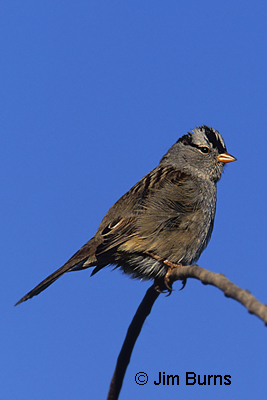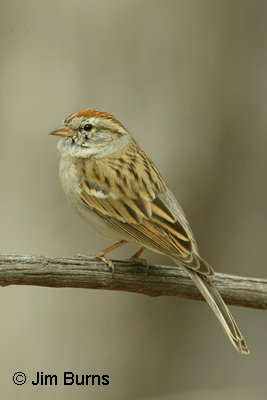|
Chipping Sparrow |
Sparrows. Why sparrows? Why now? Sparrows because they're difficult and I'd like you to expand your identification skills. Now because sparrows, like your relatives, and for the same reason, visit the Valley in winter. Our wet monsoon season has blessed us with an abundance of weeds. Sparrows have strong, conical bills evolved for husking weed seeds. This is going to be a good winter for sparrows.
There are 35 species of sparrows in North America. If your eyes glaze over as you flip through these "little brown jobs" in your field guide, if you throw up your hands in despair as they disappear into the brush before you decipher their streaks and stripes, I want you to slow down and start becoming aware of "jizz."
Jizz is an acronym for the concept of "general impression size and shape" used by plane spotters in World War II Britain to distinguish at a glance whether incoming aircraft were allies or enemies. Each of the twelve genera in the sparrow family has its own distinctive jizz. Work through them again in your field guide ignoring the streaks and stripes and look carefully at details of structure. You're looking for four things: body size and shape; head shape; bill length and shape; and tail length and shape.
All sparrows are small, 5 to 71/2 inches in length, but some seem robust and chesty while others appear small and slender. Though head shape can change as crown feathers are raised or lowered, some crowns are rounded, others flat, a few peaked. All have conical bills, but some are short and thick, some long and thin, some small and petite. Tails may be long and rounded, short and spikey, graduated, straight, or notched.
Let's compare two sparrow species common here in winter, chipping and white-crowned. Superficially they can appear very similar because winter chippies and immature white-crowneds both have reddish-brown crown stripes. Their jizz, however, is quite different. Chippies are small, slender bodied sparrows, round headed with tiny bills, and their tails are notched. White-crowneds are large sparrows, over twice the weight of chippies, with crowns typically peaked, larger bills, and long, square-tipped tails.
Forget color and begin to see difficult families of birds like sparrows from this new perspective of shape and structure. Start by studying those species you've identified, see often, and know well. Then you'll more quickly recognize differences in those unfamiliar and less common.
Look for winter sparrow flocks in brushy areas along our desert washes, and particularly at the Gilbert Riparian Area (Guadalupe & Greenfield Rds in Gilbert) and Boyce-Thompson Arboretum State Park (US 60 west of Superior). For the best in-depth study of these little brown jobs, purchase the sparrow "bible," Sparrows of the United States and Canada: the Photographic Guide, by Jim Rising and David Beadle.
Learning sparrow jizz will slow you down and force you to become a better birder. It's a challenge. It's fun. It's an excuse to be outdoors. Aren't those some of the reasons you became a birder?
